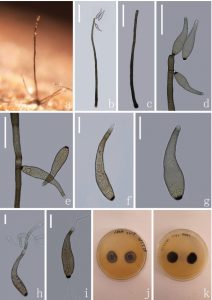Helminthosporium aquaticum H.Y. Su, Z.L. Luo & K.D. Hyde, sp. nov., Index Fungorum number: IF 551974
Etymology: Referring to the occurrence of the fungus in aquatic environments
Holotype: HKAS89692
Colonies saprobic, effuse, velvety, dark brown or black. Mycelium immersed, consisting of branched, septate, smooth, thick-walled hyphae. Conidiophores mononematous, macronematous, unbranched, dark brown, 410–580μm long (x̄=494 μm, SD=84, n=10), 13–17 μm wide (x̄=15 μm, SD=2, n=10), 14–23-septate, erect, flexuous, paler towards the apex, bulbous at base, smooth, solitary or in groups of 2–4. Conidiogenous cells polytretic, cylindrical, integrated, intercalary and terminal. Conidia 70–80 μm long (x̄=75 μm, SD=5, n=20), 16–18 μm wide (x̄=17 μm, SD=1, n=20), single, obclavate, acropleurogenous, 8–10-distoseptate, dry, pale brown to brown, straight or curved, truncate and cicatrized at base, wider than apex, dark brown, apical cell paler than other cells, guttulate. Hilum was flat ring bounded by the ruptured lateral walls. Conidial secession schizolytic.
Material examined: CHINA, Yunnan Province, Dali, Heilong stream, saprobic on decaying wood submerged in stream, March 2014, Hong-Yan Su, HLX 22–5(S-096), (HKAS89692, holotype); ex-type culture, MFLUCC 15–0357 =KUMCC; ibid. (DLU14–096, isotype).
Notes:—Based on a megablast search of NCBIs GenBank nucleotide database the closest hits using the ITS sequence of isolate S-96 are Corynespora proliferata CBS 112393 (GenBank = FJ852596, identities = 476/522 (91%), gaps = 11/522 (2%)), Helminthosporium sp. XXJW-2014a (GenBank = KJ877648, identities = 432/465 (93%), gaps = 8/465 (1%)), Corynespora olivacea CBS 291.74 (GenBank = FJ852595, identities = 475/531 (89%), gaps = 15/531 (2%)) and Helminthosporium sp. XXJW-2014b (GenBank = KJ877647; identities = 438/478 (92%), gaps = 10/478 (2%)). The Corynospora species retrieved in the megablast search grouped apart from Corynosporaceae and are likely to represent tentatively named taxa otherwise different unidentified genera. The conidia could easily be confused with species of Corynespora. However, the conidiophores of Helminthosporium are polytretic and proliferate sympodially, while those of Corynespora are monotretic and proliferate percurrently. The new species, H. aquaticum, is morphologically very similar to H. velutinum but can be distinguished based on culture characteristics and molecular data.
Fig. 4 Helminthosporium aquaticum (holotype) a Colony on the substrate. b Conidiophores and conidia. c Conidiophore. d–e Conidiogenesis. f–g Conidia. h–i Germinating conidia. j–k Cultures on MEA. Scale bars: b= 100 µm, d–e=50 µm, f–I= 20 µm.

